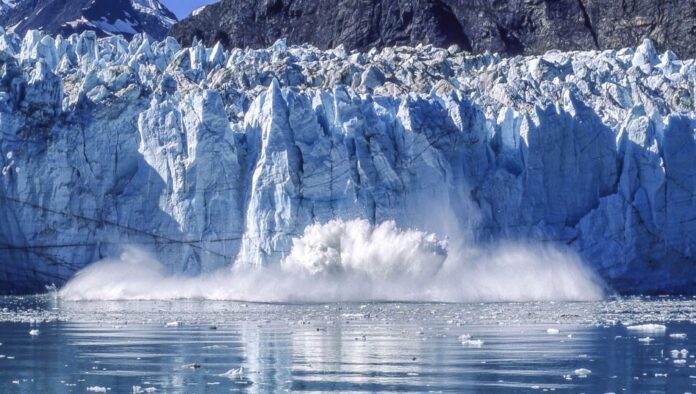A new comprehensive study has found that the world’s mountain glaciers are shrinking more than twice as fast as they were in the early 2000s, with ice loss hitting record levels in recent years due to accelerating climate change.
According to the study, published in this week’s journal Nature, glaciers lost ice at an annual rate of approximately 255 billion tons (231 billion metric tons) from 2000 to 2011. However, this rate surged to about 346 billion tons (314 billion metric tons) per year over the following decade. In 2023, the most recent year analyzed, glaciers saw a staggering 604 billion tons (548 billion metric tons) of ice loss—marking an unprecedented acceleration.
Unprecedented Ice Loss
The study, a massive international effort that compiled 233 estimates of glacier weight changes, reveals that the world’s glaciers have lost more than 7 trillion tons (6.5 trillion metric tons) of ice since 2000. Scientists warn that this trend is worsening, with significant implications for sea level rise and water supply.
“The thing that people should be aware of and perhaps worried about is that yes, the glaciers are indeed retreating and disappearing as we said they would. The rate of that loss seems to be accelerating,” said William Colgan, a glaciologist with the Geological Survey of Denmark and Greenland and one of the study’s co-authors.
Regional Disparities in Ice Loss
Glaciers in Alaska are melting at the fastest rate of any of the 19 regions studied, with an estimated 67 billion tons (61 billion metric tons) of ice lost annually. Meanwhile, Central Europe’s glaciers have shrunk by the highest percentage, now 39% smaller than in 2000. Scientists are particularly concerned about the Alps, where rising summer temperatures have dramatically accelerated glacial decline.
Fifteen years ago, scientists were most concerned about glaciers in the Andes and Patagonia, but the Alps have since emerged as one of the most vulnerable regions. Experts warn that if current trends continue, the Alps’ glaciers could eventually disappear.
Glaciers as Indicators of Climate Change
“Glaciers are apolitical and unbiased sentinels of climate change, and their decline paints a clear picture of accelerated warming,” said Gwenn Flowers, a professor of Earth Sciences at Simon Fraser University in Canada, who was not involved in the study.
University of Colorado ice scientist Ted Scambos, also unaffiliated with the study, emphasized that past variations in glacier size were driven by localized factors. However, the current widespread retreat is directly linked to human-caused climate change. “It’s due to greenhouse gas increases caused directly by coal, oil, and natural gas burning. … No amount of rhetoric, tweeting, or proclamation will change that,” Scambos stated.
Implications for the Future
Melting glaciers are now a leading contributor to global sea level rise, surpassing ice loss from Greenland and Antarctica. Only the thermal expansion of ocean water due to warming contributes more.
While some regions, such as the U.S. West, are temporarily benefiting from increased water runoff due to glacier melt, experts caution that this supply will soon vanish as glaciers approach a point of no return.
Colgan warns that the 604 billion tons of ice loss recorded in 2023, while staggering now, could become a normal occurrence within the next decade. “If you’re losing 5.5% of the global ice volume in just over 20 years, clearly that’s not sustainable,” he said. “That’s going to catch up with you.”
With ongoing warming trends and improved measurement techniques, future projections are expected to be even more concerning, reinforcing the urgency for global climate action.
Key Points:
- Glacier Melt Accelerating: Global mountain glaciers are shrinking more than twice as fast as in the early 2000s due to climate change.
- Record Ice Loss: Glaciers lost 604 billion tons (548 billion metric tons) of ice in 2023, the highest on record.
- Overall Ice Loss Since 2000: More than 7 trillion tons (6.5 trillion metric tons) of glacier ice has been lost globally since 2000.
- Fastest Melting Region: Alaska’s glaciers are melting the fastest, losing 67 billion tons (61 billion metric tons) of ice annually.
- Most Shrinking by Percentage: Central Europe’s glaciers have shrunk by 39% since 2000, with the Alps being particularly vulnerable.
- Scientific Concern: Experts warn that glacier retreat is accelerating and could soon become irreversible.
- Direct Link to Climate Change: Scientists confirm that greenhouse gas emissions from fossil fuels are the primary driver of glacier loss.
- Sea Level Rise Contribution: Melting glaciers contribute more to sea level rise than ice loss from Greenland or Antarctica.
- Future Projections Worsening: Scientists expect future assessments to be even more alarming due to continued warming and improved data.



